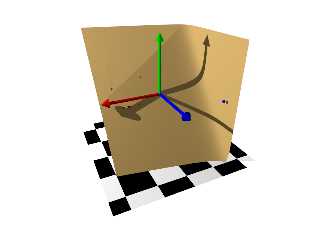|
 |
Re:
http://news.povray.org/povray.general/thread/%3Cweb.5cf316ed57960f354eec112d0%40news.povray.org%3E/
So here's the relevant section.
Little tidbits here are, the equation of a plane is Ax + By + Cz = D,
or Ax + By + Cz - D = 0.
So when you do plane {y, 0} what you're actually doing is
function {0x + 1y + 0z - 0}
I take the 3 points that will define one flat "arm" of the curved sheet and
derive the coefficients for the plane equation from the <x, y, z> coordinates.
The other plane is just a plane defined by a cardinal axis normal (but which
ought to be defined by a vector derive from the 4th point projected onto the
plane.... I'm getting there...
Multiplying the function by -1 gives the equivalent of adding the inverse
keyword.
then I just blob them together like in the documentation for isosurfaces with a
blob threshold of 0.3
#declare Point1 = <3, 0.5, -1>;
#declare Point2 = <1.5, -0.5, 0>;
#declare Point3 = <1, 1, -1>;
#declare Point4 = <-3, 0.125, 3,>; /// odd point out
#declare Z4 = Point4.x;
// derive the plane equation
#declare A1 = Point1.y*(Point2.z-Point3.z) + Point2.y*(Point3.z-Point1.z) +
Point3.y*(Point1.z-Point2.z);
#declare B1 = Point1.z*(Point2.x-Point3.x) + Point2.z*(Point3.x-Point1.x) +
Point3.z*(Point1.x-Point2.x);
#declare C1 = Point1.x*(Point2.y-Point3.y) + Point2.x*(Point3.y-Point1.y) +
Point3.x*(Point1.y-Point2.y);
#declare D1 = -1*(Point1.x*(Point2.y*Point3.z-Point3.y*Point2.z) +
Point2.x*(Point3.y*Point1.z-Point1.y*Point3.z) +
Point3.x*(Point1.y*Point2.z-Point2.y*Point1.z));
#declare Blob_Threshold=0.3;
#declare fn_A = function { -1*(A1*x + B1*y + C1*z - D1)}
#declare fn_B = function { (x - Z4) }
isosurface {
function {
(1+Blob_Threshold)
-pow(Blob_Threshold, fn_A(x,y,z))
-pow(Blob_Threshold, fn_B(x,y,z))
}
open
max_gradient 10
contained_by { box { -4, 4 } }
texture {Tan} interior_texture {Gray}
}
/*isosurface {
function {fn_A(x,y,z)}
//open
contained_by {box {-4, 4}}
texture {Blue} interior_texture {Gray}
}*/
#declare Rad = Line;
sphere {Point1 Rad texture {Red}}
sphere {Point2 Rad texture {Red}}
sphere {Point3 Rad texture {Red}}
sphere {Point4 Rad texture {Blue}}
/*intersection {
plane {<A1, B1, C1>, D1 inverse}
box {-4, 4 texture {pigment {rgbt 1}}}
texture {Green}
interior_texture {pigment {rgbt 1}}
}*/
Not robust or optimized in any way, but it shows proof of concept.
Post a reply to this message
Attachments:
Download 'documentationfigures.png' (76 KB)
Preview of image 'documentationfigures.png'

|
 |




![]()